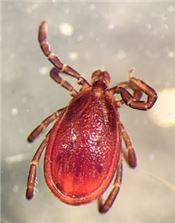Researchers To Expand Search For Cattle-Disease Transmitting Ticks

Researchers will expand their search for anaplasmosis-transmitting ticks this fall.
FAYETTEVILLE, ARK.
Researchers with the University of Arkansas System Division of Agriculture will be expanding their search this fall for ticks that may transmit anaplasmosis, a disease that can kill cattle.
Anaplasmosis turns an animal’s immune system against itself, destroying both healthy and infected red blood cells, which can starve the animal of oxygen. If anaplasmosis does not kill the infected animal, the animal carries anaplasmosis for life, becoming a reservoir for the disease.
Losses from the disease are difficult to quantify, because of the many ways anaplasmosis can kill or hinder cattle, said Heidi Ward, extension veterinarian for the Division of Agriculture. In some cases, anaplasmosis can cause calves to be aborted or slow gains in cattle. A study published in 2014 puts the annual loss to the U.S. beef cattle industry at $300 million.
“Anaplasmosis can be transmitted through ticks and their bite and through tools such as needles” such as those used to vaccinate herds, said Emily McDermott, assistant professor of entomology for the Division of Agriculture.
“We were testing ticks collected from cattle last summer and this spring, looking for the pathogen,” she said. “So far, we hadn’t found it.”
What researchers did find was a related bacteria, “and we’re going to do some genetic sequencing to determine whether or not they are pathogenic.”
Most of the samples were lone star ticks, which is not thought to be the main vector, McDermott said.
Targeting deer ticks
The researchers will focus their efforts on black-legged ticks, also known as deer ticks. This tick is best known for transmitting Lyme disease in the northeastern United States and can also transmit human anaplasmosis.
Acute cases tend to peak in summer and late fall, coinciding with peak season for the ticks that can transmit the disease.
Extension Entomologist Kelly Loftin said the research is targeting the black-legged ticks because ‘we know already that they are a good host for a related anaplasma, the one that causes anaplasmosis in humans.
We expect it might serve as a vector for the species that affects cattle.”
The black-legged ticks can also move between deer and cattle hosts.
“We’ll try to look at wildlife management areas near anaplasmosis hot spots,” he said. “Black-legged ticks tend to be more common in the fall, and by continuing to collect them from cattle and deer in the fall, we hope to get a larger number.”
Loftin said the researchers will work with the Arkansas Game and Fish Commission to collect ticks from deer harvested in-season.
Loftin said deer gun season “corresponds to the activity of the black- legged tick. That’s when you’re going to find them.”
Arkansas Game and Fish Commission State Wildlife Veterinarian Jenn Ballard said the agency is glad to be helping with this project.
“We know the that the health of humans, livestock, wildlife and environments are highly interconnected, and we strongly support any research that helps us better understand those complex relationships,” she said. ∆